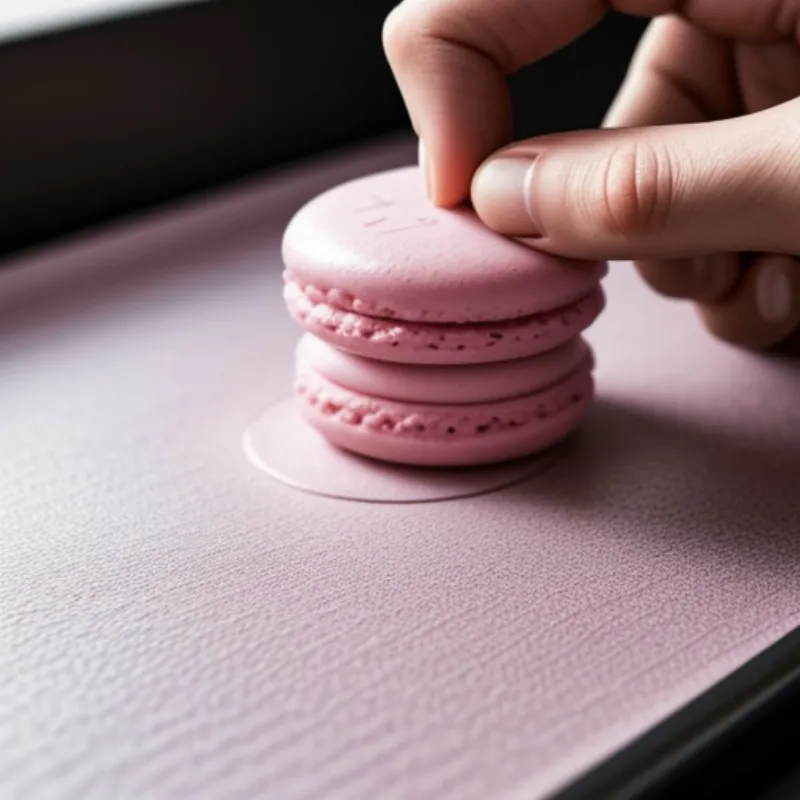Macaron sandwich cookies – those delicate, colorful confections with a delightful crunch and a chewy, flavorful center – are often seen as the pinnacle of baking prowess. But what if I told you that achieving these beautiful treats in your own kitchen is entirely within reach?
Join me as we demystify the macaron, breaking down each step with detailed instructions, helpful tips, and a touch of personal experience sprinkled in. Together, we’ll transform you from a macaron admirer into a confident creator of these little masterpieces.
Gathering Your Macaron-Making Arsenal: Ingredients and Tools
Ingredients:
Let’s start by assembling our team of ingredients. Remember, quality ingredients are the foundation of any great recipe, and macarons are no exception.
For the Macaron Shells:
- 100g almond flour, finely ground (sifting is recommended)
- 100g powdered sugar
- 90g granulated sugar
- 75g egg whites (aged for best results – more on this later!), divided
- 1/4 teaspoon cream of tartar
- Pinch of salt
- Gel food coloring of your choice (optional)
For the Filling:
- 1/2 cup (1 stick) unsalted butter, softened
- 3 cups powdered sugar
- 1/4 cup heavy cream
- 1 teaspoon vanilla extract
- Pinch of salt
A Note on Almond Flour: The fineness of your almond flour greatly affects the texture of your macaron shells. If you can find superfine almond flour, that’s ideal. Otherwise, a quick whiz in a food processor can help achieve a finer texture.
Tools of the Trade:
Now, onto the equipment. Don’t worry, you won’t need a professional pastry chef’s arsenal!
- Kitchen scale: Precision is key with macarons, so a kitchen scale is a must-have.
- Stand mixer or electric hand mixer: We’re looking for airy and stable egg whites, and a mixer is our trusty sidekick for this task.
- Sifter or fine-mesh sieve: Lumpy ingredients can lead to bumpy macarons, so sifting is crucial.
- Piping bag and round tip (about 1/2 inch): These tools help create those signature smooth and uniform macaron shells.
- Parchment paper or silicone baking mats: We want our macarons to release cleanly, and parchment paper or silicone mats are here to help.
- Baking sheets: Your trusty baking sheets will be our macaron’s stage to shine.
Crafting Macaron Perfection: A Step-by-Step Guide
Step 1: Prepping for Success
Before we dive into mixing, let’s lay the groundwork for macaron triumph:
- Age your egg whites: This step might sound a bit fussy, but trust me, it makes a difference! Aging egg whites for at least 24 hours (up to 5 days) in the refrigerator allows some of the moisture to evaporate, resulting in more stable and voluminous meringue – crucial for those coveted macaron feet.
- Organize your ingredients: Mise en place, my friends! Having all your ingredients measured and ready to go before you start mixing will make the process smoother and more enjoyable.
Step 2: Creating the Macaron Batter
-
Combine dry ingredients: In a large bowl, whisk together the almond flour and powdered sugar. This ensures they’re well combined and any lumps are broken down.
-
Whip the egg whites: In the bowl of your stand mixer (or using your hand mixer), beat the egg whites with the cream of tartar and salt on medium speed until soft peaks form.
-
Gradually add sugar: Increase the mixer speed to medium-high and gradually add the granulated sugar, a tablespoon at a time, until the meringue is thick, glossy, and holds stiff peaks.
-
Macaronage: This fancy French term refers to the crucial process of achieving the perfect macaron batter consistency. Add a third of the meringue to the dry ingredients and gently fold them together using a spatula. Once incorporated, add the remaining meringue in two more additions, folding gently until the batter flows like lava and forms a slow-moving ribbon when you lift the spatula.
Tip: Overmixing can lead to flat macarons, so be careful not to deflate the batter too much.
Step 3: Piping and Resting
-
Prepare your baking sheets: Line your baking sheets with parchment paper or silicone baking mats.
-
Pipe the macarons: Fit your piping bag with the round tip and fill it with the macaron batter. Hold the piping bag perpendicular to the baking sheet and pipe 1.5-inch circles, leaving about an inch of space between each one.
Tip: For consistent sizing, use a template (you can easily find printable ones online) or draw circles on the back of your parchment paper as a guide.
-
Rest the macarons: Allow the piped macarons to rest at room temperature for 30-60 minutes, or until they form a skin on top. This step is essential for those beautiful macaron feet to develop.
 Piping macaron batter onto a baking sheet.
Piping macaron batter onto a baking sheet.
Step 4: Baking to Perfection
-
Preheat the oven: Preheat your oven to 300°F (150°C).
-
Bake the macarons: Bake for 12-15 minutes, rotating the baking sheets halfway through, until the macarons are set and lift easily from the parchment paper.
Tip: Oven temperatures can vary, so keep a close eye on your macarons during baking.
Step 5: Creating the Filling and Assembling the Cookies
- Make the buttercream: In a mixing bowl, beat the softened butter until smooth and creamy. Gradually add the powdered sugar, followed by the heavy cream, vanilla extract, and salt. Beat until light and fluffy.
- Pair the macaron shells: Once the macaron shells have completely cooled, match them up in pairs based on size and shape.
- Fill and sandwich: Pipe or spoon a generous amount of buttercream onto the flat side of one macaron shell. Gently top with its matching shell, pressing lightly to create a sandwich.
 Assembling macaron cookies with buttercream.
Assembling macaron cookies with buttercream.
Step 6: Chilling and Enjoying
- Chill for flavor fusion: While technically you could devour your macarons right away (no judgment here!), chilling them in the refrigerator for at least 30 minutes allows the flavors to meld and the texture to set beautifully.
- Savor and share: Arrange your colorful macaron sandwich cookies on a platter and marvel at your baking accomplishment. These delicate treats are best enjoyed within a few days.
Macaron FAQs: Troubleshooting Common Questions
Q: My macarons are cracking on top. What went wrong?
A: Cracking is often a sign that the oven temperature was too high or the macarons weren’t rested long enough. Ensure your oven is properly calibrated and allow sufficient resting time for a skin to form.
Q: My macarons are hollow inside. Help!
A: Hollow macarons usually result from overmixing the batter. Be gentle during the macaronage stage and stop folding as soon as the batter flows like lava.
Q: Can I use a different filling for my macarons?
A: Absolutely! Get creative with your fillings! Ganache, fruit jams, lemon curd, and even flavored buttercream are all delicious options.
A Final Word: Embrace the Journey!
Remember, baking, much like life, is a journey filled with learning and, yes, even a few missteps along the way. Don’t be afraid to experiment, make adjustments, and most importantly, have fun while creating these delightful treats!
Now that you’re armed with the knowledge and steps to create your own macaron sandwich cookies, it’s time to roll up your sleeves, gather your ingredients, and embark on your macaron-making adventure!
We’d love to hear about your macaron triumphs (and perhaps even a few learning experiences). Share your thoughts, questions, and photos in the comments below – happy baking!
